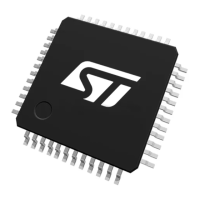RM0444 Rev 5 873/1390
RM0444 Real-time clock (RTC)
926
30 Real-time clock (RTC)
30.1 Introduction
The RTC provides an automatic wakeup to manage all low-power modes.
The real-time clock (RTC) is an independent BCD timer/counter. The RTC provides a time-
of-day clock/calendar with programmable alarm interrupts.
As long as the supply voltage remains in the operating range, the RTC never stops,
regardless of the device status (Run mode, low-power mode or under reset).
The RTC is functional in V
BAT
mode.
30.2 RTC main features
The RTC supports the following features (see Figure 281: RTC block diagram):
• Calendar with subsecond, seconds, minutes, hours (12 or 24 format), week day, date,
month, year, in BCD (binary-coded decimal) format.
• Automatic correction for 28, 29 (leap year), 30, and 31 days of the month.
• Two programmable alarms.
• On-the-fly correction from 1 to 32767 RTC clock pulses. This can be used to
synchronize it with a master clock.
• Reference clock detection: a more precise second source clock (50 or 60 Hz) can be
used to enhance the calendar precision.
• Digital calibration circuit with 0.95 ppm resolution, to compensate for quartz crystal
inaccuracy.
• Timestamp feature which can be used to save the calendar content. This function can
be triggered by an event on the timestamp pin, or by a tamper event, or by a switch to
V
BAT
mode.
• 17-bit auto-reload wakeup timer (WUT) for periodic events with programmable
resolution and period.
The RTC is supplied through a switch that takes power either from the V
DD
supply when
present or from the V
BAT
pin.
The RTC clock sources can be:
• A 32.768 kHz external crystal (LSE)
• An external resonator or oscillator (LSE)
• The internal low power RC oscillator (LSI, with typical frequency of 32 kHz)
• The high-speed external clock (HSE), divided by a prescaler in the RCC.
The RTC is functional in V
BAT
mode and in all low-power modes when it is clocked by the
LSE. When clocked by the LSI, the RTC is not functional in V
BAT
mode, but is functional in
all low-power modes except Shutdown mode.
All RTC events (Alarm, WakeUp Timer, Timestamp) can generate an interrupt and wakeup
the device from the low-power modes.

